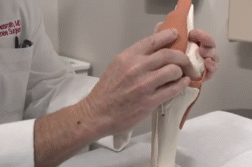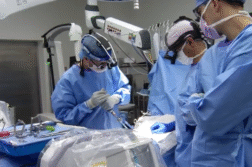CHICAGO, Ill. (Ivanhoe Newswire) – The average American takes 8,000 to 10,000 steps a day, which adds up to 115,000 miles in a lifetime – this is more than four times the circumference of the globe! It’s no wonder ankle fractures, usually caused by twisting an ankle, are one of the most common injuries. Now, new technology is allowing patients to get up and get moving faster than ever before.
From sticking a landing with a broken ankle to a game stopping ankle fracture, you don’t have to be a professional athlete to feel the pain.
Orthopedic surgeon, David Garras, MD, says, “The most common injury is a twisting injury.”
And those twisting injuries can end up in an ankle fracture.
“Traditionally, what we typically do is make an incision over the broken bone. We put a plate over the top of it with screws going in and the plate sits on the outside of the bone, which is directly really under the skin,” Dr. Garras explains.
At some point, the plates and screws will have to be removed. Now, Dr. Garras is using new technology, called the FibuLock Fibular Nail, to fix the fracture.
Dr. Garras further explains, “What the newer technology has allowed us to do now is develop implants that are specific for these types of ankle fractures that have both fixation above the fracture and below the fracture.”
The new technology uses several tiny incisions to place the rod inside – not outside – the fibula. Patients can walk on the ankle immediately and return to normal activity within two weeks. There is also less atrophy, less weakness, less risk of hardware problems, and less risk of infection.
Dr. Garras believes the FibuLock Nail procedure will save medical costs in the long run as the nails rarely have to be removed, so patients can avoid a second surgery and the increased risk of infections.
Contributors to this news report include Marsha Lewis, Producer; Roque Correa, Videographer & Editor.
To receive a free weekly e-mail on medical breakthroughs from Ivanhoe, sign up at: http://www.ivanhoe.com/ftk
Sources:
https://www.podiatrygroup.us/blog/2019/1/2/ten-fun-facts-about-your-feet-and-ankles
https://emedicine.medscape.com/article/85224-overview
MEDICAL BREAKTHROUGHS
RESEARCH SUMMARY
TOPIC: GET UP & GET MOVING! REPAIRING ANKLE FRACTURES FASTER
REPORT: MB #5118
BACKGROUND: The ankle fracture is one of the most common existing injuries, an estimated 3.9-10.2% of adult fractures. The most injured part of the bone in an ankle fracture is the fibula. If the bone is only broken in one place, it can usually be treated with surgery. If a fracture does require surgery generally, it’s treated through an incision. Due to the ankle joint and bone placement being compounded, healing can become slowed and result in other complications regarding one’s physical health.
(Source: https://www.frontiersin.org/articles/10.3389/fsurg.2022.853101/full)
DIAGNOSING: The most frequent indication of a broken ankle is tenderness, bruising, restricted range of motion, and precarious feelings in the ankle. The diagnosis of the fractured bone will involve a physical followed by an X-Ray, MRI, CT scan, and an ultrasound. If surgery is required, the first two weeks of healing require rest, elevation of the affected area, compression, and ice. Over the counter pain medications such as Ibuprofen, Aleve, and Tylenol are often prescribed to patients experiencing severe pain during recovery periods. After the first phases of recovery and pain pass, doctors and physical therapists will prescribe a series of movements and strength training to help patients regain mobility. In some cases of
failures to heal, additional surgery is required.
(Source: https://www.mayoclinic.org/diseases-conditions/sprained-ankle/diagnosis-treatment/drc-20353231)
NEW TECHNOLOGY: New advances in technology have allowed medical professionals to create implants for certain ankle fractures that help fix areas above and below the ankle fracture. This is allowing smaller incisions as opposed to larger incisions to be made during surgeries. Ankle plates are created to provide more support for the fracture. There is a faster recovery time with a plate and screw because, in most cases, it allows people to walk on the ankle almost immediately following surgery.
(Source: https://www.acumed.net/products/foot-ankle/ankle-plating-system/)
FOR MORE INFORMATION ON THIS REPORT, PLEASE CONTACT:
Lisa Stafford
lisa@staffordsommunicationsinc.com
If this story or any other Ivanhoe story has impacted your life or prompted you or someone you know to seek or change treatments, please let us know by contacting Marjorie Bekaert Thomas at mthomas@ivanhoe.com




